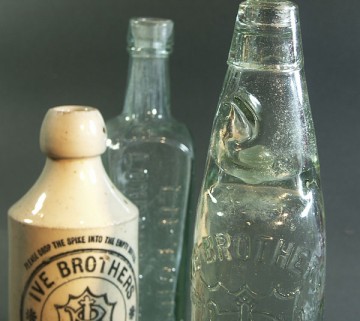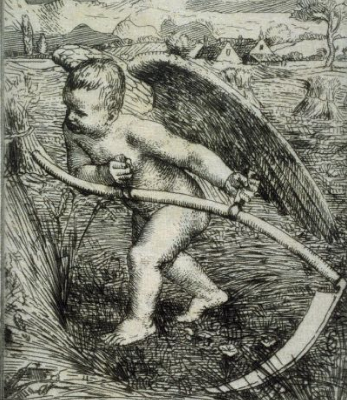
Live in a 400 year-old house and you grow accustomed to the closeness of the past. Reminders of those long gone are many. Ten generations born, living and dying here, each leaving their traces, some obvious, others more subtle. Work the garden and the soil gives up the stuff of others' lives.
The dark loam seems animate, constantly pushing to the surface unexpected bits and pieces: a little wooden whistle, lost in a child's contented game a century or more ago. A mangled lead buckle, its decoration twisted by a bonfire that consumed an unwanted dress. Big old pre-decimal pennies, never again to be spent, one of solid bronze from the time of the Napoleonic War. Broken clay pipes, discarded by other gardeners 200 or more years ago. And the countless potsherds! Many of them red but most blue willow pattern, the fleeing Chinese lovers long since broken apart: this shattered plate fragment from a service given as a wedding present, accidentally dropped or perhaps hurled to the floor in a blazing row.
Weeding the rose bed a couple of years ago, I picked out of the earth a beautifully-lettered Boots cherry tothpaste lid. Since the First World War it had lain safely hidden, deep in the same soil which had now, wonderfully, given it up. It reminded me a happy few weeks in my boyhood spent digging over a midden left by our Victorian predecessors.

The glass and stoneware bottles we recovered shed light on past lives. If the number of syrup of figs bottles is any guide, constipation was a real problem in the 1940s. We found just one of Hiram Codd's fascinating glass ball sealed fizzy pop bottles (the origin of the phrase 'codswallop').
Solid aquamarine torpedo-shaped bottles containing lemonade made to William Hamilton's 1809 Dublin patent. Trapped air bubbles and the the heavy, imperfect blue-green glass makes these old bottles seem intriguing and precious. Beautifully embossed lettering and transfer-decorated stoneware, proclaiming the names of long-lost local ginger beer manufacturers: Lovibond and the Ive Brothers of Henley-on-Thames, (patent Galtee More closures), the Tunbridge Jones Company of Reading.
The Boots logo must be one of the most enduring on the High Street. Its present-day lettering is almost identical to that we found on late 19th century medicine bottles. Salt-glazed ink pots with a pouring lip, a dark green Bovril jar that makes even that product alluring, and cobalt-blue poison bottles, heavily ribbed to warn the blind of their dangerous contents. I even found a complete Victorian spittoon, perhaps half-inched from a local pub by a boisterous local lad, and then embarrasedly discarded on the rubbish heap.

 Yesterday I took down my father's full size scythe for the first time since his death in 1990. He looked after it well, cleaning and honing the long blade, ideally shaped for cutting down the nettles at the bottom of the garden. The long wooden handle, with its two hand grips worn smooth from years of use, curves with potent elegance, making scything a kind of dance: my body twists as the blade slices, lopping the heads off the nettles as they fall to the ground. But I've never used my father's scythe before, and I haven't yet sharpened it and the blade catches on something tough in the undergrowth. He always took care never to do that. The thin, curved tip of the blade is torn and as I fiddle with it pointlessly, comes away in my hand. And in that moment I am suddenly ashamed as I hear his voice in my head: 'now that wasn't a very clever thing to do'.
Yesterday I took down my father's full size scythe for the first time since his death in 1990. He looked after it well, cleaning and honing the long blade, ideally shaped for cutting down the nettles at the bottom of the garden. The long wooden handle, with its two hand grips worn smooth from years of use, curves with potent elegance, making scything a kind of dance: my body twists as the blade slices, lopping the heads off the nettles as they fall to the ground. But I've never used my father's scythe before, and I haven't yet sharpened it and the blade catches on something tough in the undergrowth. He always took care never to do that. The thin, curved tip of the blade is torn and as I fiddle with it pointlessly, comes away in my hand. And in that moment I am suddenly ashamed as I hear his voice in my head: 'now that wasn't a very clever thing to do'.